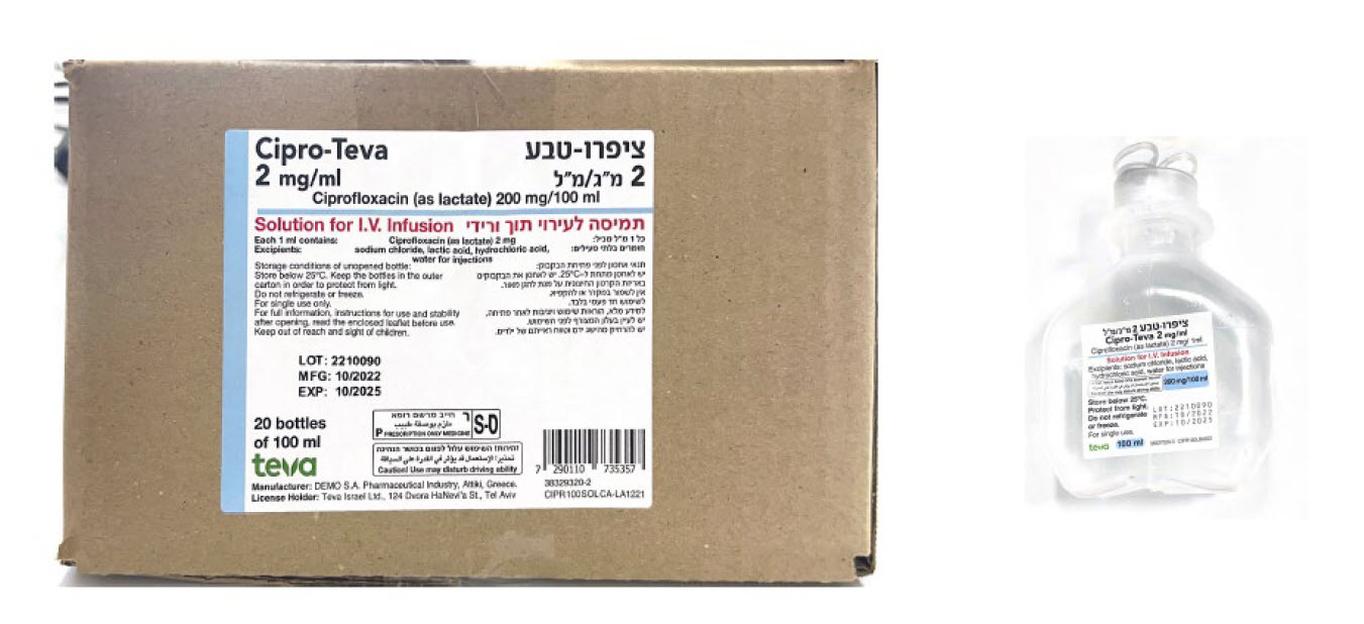Quest for the right Drug

ציפרו-טבע ® 2 מ"ג/מ"ל CIPRO-TEVA ® 2 MG/ML (CIPROFLOXACIN AS LACTATE)
תרופה במרשם
תרופה בסל
נרקוטיקה
ציטוטוקסיקה
צורת מתן:
תוך-ורידי : I.V
צורת מינון:
תמיסה לאינפוזיה : SOLUTION FOR INFUSION
עלון לרופא
מינוניםPosology התוויות
Indications תופעות לוואי
Adverse reactions התוויות נגד
Contraindications אינטראקציות
Interactions מינון יתר
Overdose הריון/הנקה
Pregnancy & Lactation אוכלוסיות מיוחדות
Special populations תכונות פרמקולוגיות
Pharmacological properties מידע רוקחי
Pharmaceutical particulars אזהרת שימוש
Special Warning עלון לרופא
Physicians Leaflet
Pharmacological properties : תכונות פרמקולוגיות
Pharmacodynamic Properties
5.1 Pharmacodynamic properties Pharmacotherapeutic category: fluoroquinolones, ATC-code: J01MA02 Mechanism of action: As a fluoroquinolone antibacterial agent, the bactericidal action of ciprofloxacin results from the inhibition of both type II topoisomerase (DNA gyrase) and topoisomerase IV, required for bacterial DNA replication, transcription, repair and recombination. Pharmacokinetic/pharmacodynamic relationship Efficacy mainly depends on the relation between the maximum concentration in serum (Cmax) and the minimum inhibitory concentration (MIC) of ciprofloxacin for a bacterial pathogen and the relation between the area under the curve (AUC) and the MIC. Mechanism of resistance: In-vitro resistance to ciprofloxacin can be acquired through a stepwise process by target site mutations in both DNA gyrase and topoisomerase IV. The degree of cross- resistance between ciprofloxacin and other fluoroquinolones that results is variable. Single mutations may not result in clinical resistance, but multiple mutations generally result in clinical resistance to many or all active substances within the class. Impermeability and/or active substance efflux pump mechanisms of resistance may have a variable effect on susceptibility to fluoroquinolones, which depends on the physiochemical properties of the various active substances within the class and the affinity of transport systems for each active substance. All in-vitro mechanisms of resistance are commonly observed in clinical isolates. Resistance mechanisms that inactivate other antibiotics such as permeation barriers (common in Pseudomonas aeruginosa) and efflux mechanisms may affect susceptibility to ciprofloxacin. Plasmid-mediated resistance encoded by qnr-genes has been reported. Spectrum of antibacterial activity: Breakpoints separate susceptible strains from strains with intermediate susceptibility and the latter from resistant strains: EUCAST recommendations Micro-organisms Susceptible Resistant Enterobacteriaceae S ≤ 0.25 mg/L R > 0.5 mg/L Salmonella spp. S ≤ 0.06 mg/L R > 0.06 mg/L Pseudomonas spp. S ≤ 0.5 mg/L R > 0.5 mg/L Acinetobacter spp. S ≤ 1 mg/L R > 1 mg/L Staphylococcus spp.1 S ≤ 1 mg/L R > 1 mg/L Haemophilus influenzae S ≤ 0.06 mg/L R > 0.06 mg/L Moraxella catarrhalis S ≤ 0.125 mg/L R > 0.125 mg/L Neisseria gonorrhoeae S ≤ 0.03 mg/L R > 0.06 mg/L Neisseria meningitidis S ≤ 0.03 mg/L R > 0.03 mg/L Non-species-related breakpoints * S ≤ 0.25 mg/L R > 0.5 mg/L 1 .Staphylococcus spp. - breakpoints for ciprofloxacin related to high dose therapy. * Non-species-related breakpoints have been determined mainly on the basis of PK/PD data and are independent of MIC distributions of specific species. They are for use only for species that have not been given a species-specific breakpoint and not for those species where susceptibility testing is not recommended. The prevalence of acquired resistance may vary geographically and with time for selected species and local information on resistance is desirable, particularly when treating severe infections. As necessary, expert advice should be sought when the local prevalence of resistance is such that the utility of the agent in at least some types of infections is questionable. Groupings of relevant species according to ciprofloxacin susceptibility (for Streptococcus species see section 4.4): COMMONLY SUSCEPTIBLE SPECIES Aerobic Gram-positive micro-organisms Bacillus anthracis (1) Aerobic Gram-negative micro-organisms Aeromonas spp. Brucella spp. Citrobacter koseri Francisella tularensis Haemophilus ducreyi Haemophilus influenzae* Legionella spp. Moraxella catarrhalis* Neisseria meningitidis Pasteurella spp. Salmonella spp.* Shigella spp. * Vibrio spp. Yersinia pestis Anaerobic micro-organisms Mobiluncus Other micro-organisms Chlamydia trachomatis ($) Chlamydia pneumoniae ($) Mycoplasma hominis ($) Mycoplasma pneumoniae ($) SPECIES FOR WHICH ACQUIRED RESISTANCE MAY BE A PROBLEM Aerobic Gram-positive micro-organisms Enterococcus faecalis ($) Staphylococcus spp. *(2) Aerobic Gram-negative micro-organisms Acinetobacter baumannii+ Burkholderia cepacia +* Campylobacter spp.+* Citrobacter freundii* Enterobacter aerogenes Enterobacter cloacae * Escherichia coli* Klebsiella oxytoca Klebsiella pneumoniae* Morganella morganii* Neisseria gonorrhoeae* Proteus mirabilis* Proteus vulgaris* Providencia spp. Pseudomonas aeruginosa* Pseudomonas fluorescens Serratia marcescens* Anaerobic micro-organisms Peptostreptococcus spp. Propionibacterium acnes INHERENTLY RESISTANT ORGANISMS Aerobic Gram-positive micro-organisms Actinomyces Enteroccus faecium Listeria monocytogenes Aerobic Gram-negative micro-organisms Stenotrophomonas maltophilia Anaerobic micro-organisms Excepted as listed above Other micro-organisms Mycoplasma genitalium Ureaplasma urealitycum *: Clinical efficacy has been demonstrated for susceptible isolates in approved clinical indications +: Resistance rate ≥ 50% in one or more EU countries ($): Natural intermediate susceptibility in the absence of acquired mechanism of resistance (1): Studies have been conducted in experimental animal infections due to inhalations of Bacillus anthracis spores; these studies reveal that antibiotics starting early after exposition avoid the occurrence of the disease if the treatment is made up to the decrease of the number of spores in the organism under the infective dose. The recommended use in human subjects is based primarily on in-vitro susceptibility and on animal experimental data together with limited human data. Two-month treatment duration in adults with oral ciprofloxacin given at the following dose, 500 mg bid, is considered as effective to prevent anthrax infection in humans. The treating physician should refer to national and /or international consensus documents regarding treatment of anthrax. (2): Methicillin-resistant S. aureus very commonly expresses co-resistance to fluoroquinolones. The rate of resistance to methicillin is around 20 to 50% among all staphylococcal species and is usually higher in nosocomial isolates.
Pharmacokinetic Properties

שימוש לפי פנקס קופ''ח כללית 1994
לא צוין
תאריך הכללה מקורי בסל
לא צוין
הגבלות
לא צוין
מידע נוסף
